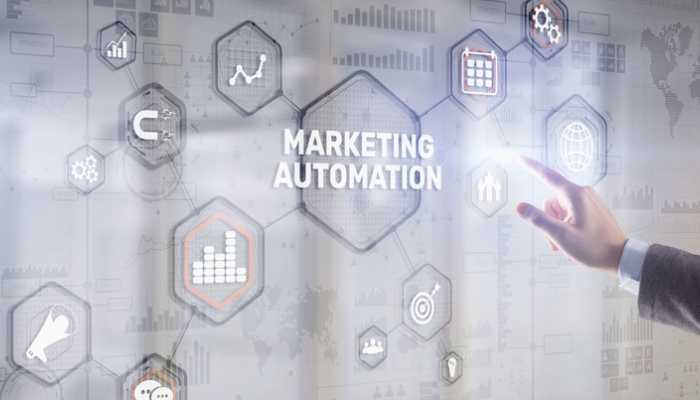Marketing automation can play a powerful role in your life sciences marketing strategy. The typical buying cycle for prospects in the life sciences industry is often long and complex, as the process often encompasses multiple stakeholders moving along a non-linear purchase journey. This can mean that prospects require a series of marketing and sales touchpoints over time to encourage them to purchase. Fortunately, there is a wide range of tools available to support life science marketers in their quest to make the lead management process more efficient and easier to scale.
One approach is to use a marketing automation system. For many companies, investing in marketing automation typically generates an increase in revenue and provides an excellent return on investment ROI (in one study, 75% of companies that implemented marketing automation reported seeing an ROI within as little as 12 months).
In this post, we delve deeper into the top five benefits of marketing automation for life science marketers, and why investing in automation can take your life sciences marketing efforts to the next level.
What is marketing automation?
To truly appreciate the benefits, it’s important to first understand what marketing automation is. Essentially, marketing automation is an umbrella term for software and technology that you can utilise to automate repetitive tasks like email marketing, social media posting, the management of paid ad campaigns and more. This allows organisations to more effectively and efficiently market to their audiences across a variety of online channels.
The ability to automate aspects of your marketing allows you to provide your prospects with personalised content that fulfils their needs, driven by previous actions they’ve taken. With manual marketing processes, this is exceedingly difficult and complicated to accomplish, even just for a handful of prospects. Now multiply the number of prospects tenfold and the process becomes unmanageable. To solve this problem, marketing automation systems track the behaviour and interactions of your prospects across all marketing channels to form a picture of each individual’s interests, using this information to automatically deliver them follow-up information that is tailored to their needs.
For life science marketers, this means we can nurture healthcare providers, hospital administrators, research scientists, pharma decision-makers, and other life science professionals with relevant and valuable content that can help better convert them into customers. Marketing automation can also be used in this way to increase the satisfaction of existing customers, generate repeat business, trigger upsell opportunities and more.
What are the advantages of life science marketing automation?
1. Generate better leads
Generating leads is a vital part of any life science organisation’s growth. Marketing automation systems can help automate the manual, more tedious administration steps to give sales and marketing teams extra time to focus on generating more leads and nurturing the leads that show true buying intent to drive sales conversations. Ultimately, this means more leads, better-qualified prospects and more customers.
Not only this, but marketing automation gives life science companies a more complete picture of who their customers are by using behavioural tracking methods. In turn, this allows companies to market better because they can take into account the behaviour of individual leads to drive personalised follow-up actions. Through more streamlined tracking and monitoring, you can also determine things like which of your marketing channels are more effective and which messages are resonating most with your buyers.
2. Nurture leads more efficiently and effectively
B2B lead generation is only the first step. As mentioned in our previous blog post on the foundational aspects of lead nurturing for life sciences, not all leads are created equal and very few leads will be ready to buy from you when you first gather their contact details. This makes lead nurturing a critical part in guiding a lead through your sales process from being a prospect to a customer.
By setting up automated email workflows and tracking, you can trigger emails to be sent to each prospect after they’ve taken a specific action (e.g. downloaded a particular piece of content). These workflows can send the prospect relevant content that will help them through their decision-making process, while also making it easier for you to monitor and track leads as they move through your sales funnel.
Taken to the next level, marketing automation tools can also help you create more complex workflows to nurture leads and provide them with relevant content delivered across a series of channels like emails and programmatic ads (the likes of which would previously have been very time-consuming to carry out manually).
3. Make smarter decisions to improve performance, driven by data
By using marketing automation, you can effectively unlock the power of your data and in the process collect valuable intelligence to help you build a better picture of your contacts with just a few clicks of a button.
Marketing automation platforms also offer marketers several advanced tools, such as a single platform for dashboarding and analytics, closed-loop reporting, and collecting and storing data. This can make it easier to access and manipulate large amounts of invaluable data, and in turn, identify patterns and trends which might not have been spotted with manual methods.
Through such insights, marketing automation can help you reveal pivotal moments in your marketing and sales process. It can also make it easier for companies to perform A/B testing on campaigns to find the factors that work best and truly understand how they impact on lead generation, purchasing and revenue.
This more data-driven approach can help generate higher-quality leads, reduce customer churn rate, improve customer engagement, and provide a more superior customer experience.
4. Personalise content at scale to better engage prospects
When it comes to marketing in the life sciences, a one-size-fits-all approach will usually lead to suboptimal results. Personalised content that is tailored to individuals based on information you know about them is a great way to grab the attention of your prospects and trigger engagement. However, this can prove challenging and laborious to do manually.
Marketing automation systems allow you to personalise content at scale for a large number of leads (but with minimal manual effort). By automatically capturing informative data about their needs and pain points based on the content they consume, you can get a better feel for what other types of content will help them make a more informed buying decision. You can then set up automated email workflows to deliver other relevant content to them over time, making people feel like you are communicating with them in a one-to-one fashion, laser focussing in on the things they personally care most about.
The marketing automation platform can keep track of which emails customers are opening and clicking on, what social media posts are performing well, and how all that converts into website visits and other user actions. By using this data, it is much easier to target a large number of customers in a personalised way with the right content at the right time. Being able to build up as much knowledge on your prospects as possible to tailor your approach can prove vital in convincing them to purchase your product over a competitor.
5. Help ensure sales and marketing are on the same page
One of the main bottlenecks that life science companies can experience is a misalignment between their sales and marketing teams. This can lead to inefficient collaboration between these teams (and a poor experience for the customer).
How does this happen? Well, one problem is that these teams often work with different tools toward separate departmental goals. This can cause misalignment. By integrating your sales-driven Customer Relationship Management (CRM) system with a marketing automation platform, you can combine their strengths and track closed deals all the way back to where the lead originated from, providing a clearer view of a customer’s journey than ever before. This approach also prevents unnecessary duplication of contact information making data management less time-consuming.
By using the data collected from your CRM and marketing automation platforms, you can score your leads based on their interest level and behaviour to determine their sales-readiness for follow-up. This way, only the highest quality leads get passed on to your sales team, increasing their efficiency by ensuring they’re not wasting time on leads that aren’t yet ready to buy (which also tends to make salespeople happier and more productive).
Should we invest in a marketing automation platform?
Marketing automation systems offer powerful tools for life science marketers to automate previously repetitive tasks. Put simply, they save time, effort, resources and money.
With the ability to better track prospect and customer behaviour at scale, marketers can more easily cope with an increase in leads with less room for error, make more informed strategic decisions and tailor future campaigns for maximum impact. Automating common tasks also gives marketers additional time back to experiment with more new marketing approaches, channels, tactics and content formats to drive improved performance.
However, the decision to implement marketing automation should not be made lightly and a clear plan for automation implementation should be established.
To help life science organisations plan for the successful implementation of marketing automation, we’ve put together a 10-step marketing automation ‘readiness’ tool. Simply fill in the short questionnaire for advice and recommendations on how to ensure your marketing automation project is as smooth and successful as possible.




